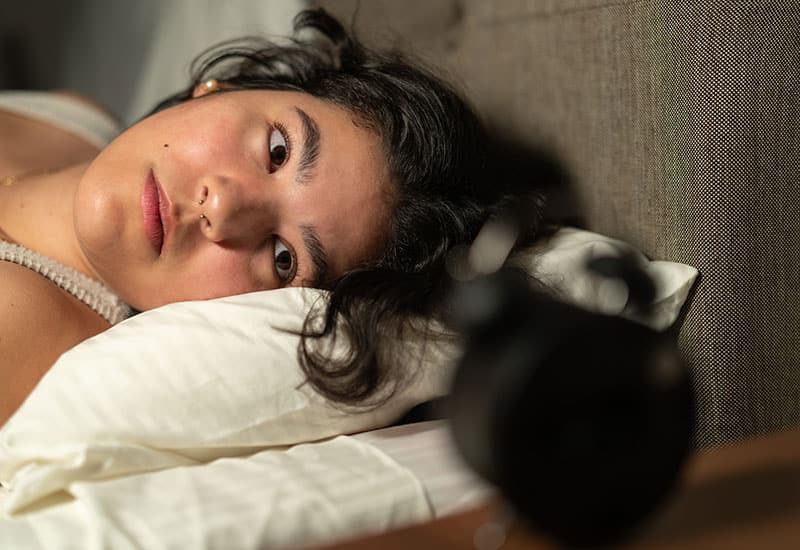Belsomra vs. Ambien: Key Similarities and Differences
Medically Reviewed By:
Written By:
Updated On: September 1, 2025
Last Medically Reviewed on: September 1, 2025

Table of Contents
Key Points
- Belsomra and Ambien are both prescription sleep medications that treat insomnia, but they work through different mechanisms: Belsomra blocks orexin receptors that promote wakefulness, while Ambien enhances the activity of the GABA neurotransmitter for calming effects.
- Ambien works faster and is more effective for inducing sleep, while Belsomra takes longer to take effect but provides better sleep maintenance throughout the night with a lower risk of dependency and dangerous sleep behaviors.
- Both medications require careful medical supervision and at least seven hours of dedicated sleep time, though Belsomra generally presents a safer profile with less potential for addiction and withdrawal symptoms compared to Ambien.
Belsomra and Ambien are two prescription sleep medications that help people struggling with insomnia fall asleep and stay asleep throughout the night. While both drugs treat similar sleep disorders, they work through entirely different mechanisms in the brain and offer distinct advantages and disadvantages for people seeking better sleep quality. Belsomra blocks orexin receptors that promote wakefulness, while Ambien enhances the calming effects of a neurotransmitter called GABA.
What is Belsomra?
Belsomra is a prescription sleep medication that contains the active ingredient suvorexant, which belongs to a newer class of drugs called dual orexin receptor antagonists.[1] The medication works by blocking orexin receptors in the brain that typically promote wakefulness and alertness. Healthcare providers prescribe Belsomra specifically for people who have trouble falling asleep or staying asleep throughout the night, making it an effective treatment for both sleep onset and sleep maintenance insomnia.
The drug received FDA approval in 2014 and represents a different approach to treating sleep disorders compared to older sleep medications. Belsomra comes in tablet form with dosage strengths of five, 10, 15, and 20 milligrams, allowing healthcare providers to customize treatment based on individual patient needs. The medication is typically taken once per night, within 30 minutes of bedtime. People should plan to have at least seven hours of sleep before taking their dose.
What is Ambien?
Ambien is a prescription sleep medication that contains the active ingredient zolpidem, which belongs to a class of drugs called sedative-hypnotics or “Z-drugs.”[2] The medication works by enhancing the activity of GABA, a neurotransmitter that produces calming effects in the brain and central nervous system. Healthcare providers commonly prescribe Ambien for people who have difficulty falling asleep, though it primarily targets sleep onset rather than maintaining sleep throughout the night.
The FDA approved Ambien in 1992, making it one of the most widely prescribed sleep medications in the United States for over three decades. The drug is available in both immediate-release and extended-release formulations, with immediate-release tablets offered in 5- and 10-milligram strengths, and extended-release versions in 6.25- and 12.5-milligram strengths. People typically take Ambien once per night on an empty stomach, and the medication should only be used when they can dedicate a full seven to eight hours to sleep.
How Are These Medications Similar?
Belsomra and Ambien share several essential characteristics as prescription sleep medications designed to help people overcome insomnia and achieve better sleep quality.[3] Both drugs require careful medical supervision and come with specific guidelines for safe and effective use.
- Prescription requirement: Both medications require a valid prescription from a healthcare provider and cannot be purchased without a prescription.
- Insomnia treatment: Both drugs effectively treat sleep disorders, particularly difficulty falling asleep.
- Bedtime dosing: People take both medications once per night within 30 minutes of going to bed.
- Sleep duration requirement: Both drugs require at least seven to eight hours of dedicated sleep time after taking the dose.
- FDA approval: The FDA has approved both medications as safe and effective treatments for insomnia.
- Controlled substances: Both Belsomra and Ambien are classified as controlled substances due to their potential for dependence.
- Side effect profiles: Both medications can cause drowsiness, dizziness, and next-day impairment if not taken properly.
- Drug interaction potential: Both drugs can interact with alcohol, other sleep medications, and certain prescription drugs.
- Age considerations: Healthcare providers typically prescribe lower doses of both medications for older adults.
- Short-term use recommendation: Medical professionals generally recommend both drugs for short-term treatment of insomnia.
Key Differences Between Belsomra and Ambien
While Belsomra and Ambien both treat insomnia, they differ in their mechanisms of action, onset times, dependency risks, and overall effects on sleep:[4]
- Mechanism of action: Belsomra blocks orexin receptors that promote wakefulness, while Ambien enhances GABA neurotransmitter activity.
- Onset of action: Ambien works faster, typically within 15 to 30 minutes, while Belsomra may take 30 to 60 minutes to take effect.
- Primary sleep benefit: Ambien primarily helps with falling asleep, while Belsomra helps both with falling asleep and staying asleep.
- Dependency potential: Ambien carries a higher risk for physical dependence and tolerance, while Belsomra has lower addiction potential.
- Withdrawal symptoms: Stopping Ambien may cause rebound insomnia and withdrawal effects, while Belsomra typically causes fewer withdrawal issues.
- Sleep architecture: Belsomra preserves natural sleep stages better, while Ambien can alter normal sleep patterns.
- Duration of action: Belsomra has a longer half-life and may provide sleep maintenance benefits throughout the night.
- Age of medication: Ambien has been available since 1992 with extensive long-term data, while Belsomra received approval in 2014.
- Generic availability: Generic versions of Ambien are widely available and less expensive, while Belsomra remains brand-name only.
- Complex sleep behaviors: Ambien has a higher risk for sleepwalking and sleep-eating behaviors compared to Belsomra.
Is Belsomra Safer Than Ambien?
Belsomra generally presents a safer profile than Ambien in several key areas, particularly regarding dependency risk and complex sleep behaviors.[5] The newer medication has a lower potential for physical dependence, tolerance, and withdrawal symptoms compared to Ambien, which belongs to a class of drugs known for their addictive properties.
Belsomra also carries significantly less risk for dangerous sleep-related behaviors such as sleepwalking, sleep-driving, or sleep-eating that have been reported with Ambien use. The orexin receptor antagonist mechanism of Belsomra preserves more natural sleep architecture, potentially leading to better quality rest without the same level of next-day cognitive impairment.
However, both medications carry essential safety considerations that require careful medical supervision and adherence to prescribed dosing guidelines. Ambien’s longer track record, since 1992, provides extensive data on its long-term effects and safety profile, while Belsomra’s newer approval in 2014 means that less comprehensive long-term safety information is available.
Individual factors such as age, other medications, medical conditions, and specific sleep problems ultimately determine which medication poses fewer risks for each person. Healthcare providers must weigh the benefits and risks of each option based on the person’s comprehensive health picture, rather than assuming that one medication is universally safer than another.
Which Medication is More Effective for Different Types of Insomnia?
The effectiveness of Belsomra versus Ambien depends mainly on the specific type of insomnia a person experiences, with each medication showing distinct advantages for different sleep problems.
Ambien is effective for sleep onset insomnia, where people struggle primarily with falling asleep initially.[6] The medication’s rapid onset of action, within 15 to 30 minutes, makes it particularly effective for individuals who lie awake for extended periods before falling asleep. Clinical studies consistently show Ambien’s ability to significantly reduce the time it takes to fall asleep, making it the preferred choice for pure sleep initiation problems.
Belsomra proves more effective for sleep maintenance in insomnia, where people fall asleep relatively easily but wake up frequently during the night or too early in the morning.[7] The medication’s more prolonged duration of action and ability to block wakefulness-promoting orexin signals throughout the night help people stay asleep for more extended periods. Research indicates that Belsomra users experience fewer middle-of-the-night awakenings and spend more total time asleep compared to those taking Ambien.
For people with mixed insomnia who struggle with both falling asleep and staying asleep, Belsomra often provides more comprehensive sleep benefits, though individual responses vary significantly based on the underlying causes of their sleep disruption and personal health factors.
Frequently Asked Questions About Belsomra vs. Ambien
Can I switch from Ambien to Belsomra without experiencing withdrawal symptoms?
Switching from Ambien to Belsomra should always be done under the guidance of a healthcare provider, as both are Schedule IV controlled substances that can cause withdrawal symptoms when discontinued abruptly. Ambien (zolpidem) is a sedative-hypnotic that affects GABA receptors in the central nervous system, and stopping it suddenly after regular use can lead to rebound insomnia, anxiety, and other withdrawal effects.
Your provider may recommend gradually tapering your Ambien dose before starting Belsomra, which works as an orexin receptor antagonist rather than affecting GABA. Clinical trials show that Belsomra has a lower potential for physical dependence compared to traditional sleeping pills, but the transition process requires careful monitoring to ensure you don’t experience severe sleep problems or other complications during the medication change.
Which medication has fewer side effects — Belsomra or Ambien?
Both Belsomra and Ambien can cause drowsiness and next-day impairment, but they differ in their side effect profiles and risk for dangerous behaviors. Common side effects of Belsomra include sleepiness, dry mouth, and occasional sleep paralysis, while the effects of Ambien include drowsiness, dizziness, and gastrointestinal issues.
However, Ambien carries a significantly higher risk for complex sleep behaviors such as sleepwalking, sleep-driving, and sleep-eating that can be dangerous and potentially life-threatening. The FDA has issued warnings about these complex behaviors with zolpidem and other sedative-hypnotic sleep aids.
Belsomra generally shows fewer drug interactions with other prescription drugs, antidepressants, and CNS depressants, though both medications should be avoided with opioids due to the risk of respiratory depression. People with sleep apnea or other breathing disorders may experience fewer respiratory side effects with Belsomra compared to traditional sleep medications.
Is there a generic version available for either medication, and does it affect treatment options?
Currently, only Ambien has generic versions available (zolpidem), while Belsomra remains a brand-name medication manufactured by Merck with no generic alternatives. This cost difference significantly impacts treatment options, as generic zolpidem is much more affordable than brand-name Belsomra. The generic version of zolpidem is available in both immediate-release and extended-release (Ambien CR) formulations, offering multiple treatment options for various sleep disorders.
There is a Better Way to Live. It's Time to Get the Help You Deserve.
Take the first step in getting your life back. Speak with our admissions team today.Sources
[1] HIGHLIGHTS OF PRESCRIBING INFORMATION. (n.d.). https://www.merck.com/product/usa/pi_circulars/b/belsomra/belsomra_pi.pdf on August 27, 2025
[2] HIGHLIGHTS OF PRESCRIBING INFORMATION. (n.d.). https://www.accessdata.fda.gov/drugsatfda_docs/label/2008/019908s027lbl.pdf on August 27, 2025
[3, 4] Ambien vs Belsomra Comparison. (2025). Drugs.com. https://www.drugs.com/compare/ambien-vs-belsomra on August 27, 2025
[5] Kripke, D. F. (2015). Is suvorexant a better choice than alternative hypnotics? F1000Research, 4, 456. https://pmc.ncbi.nlm.nih.gov/articles/PMC4648222/ on August 27, 2025
[6] Edinoff, A. N., Wu, N., Ghaffar, Y. T., Prejean, R., Gremillion, R., Cogburn, M., Chami, A. A., Kaye, A. M., & Kaye, A. D. (2021). Zolpidem: Efficacy and side effects for insomnia. Health Psychology Research, 9(1), 1–14. https://pmc.ncbi.nlm.nih.gov/articles/PMC8567759/ on August 27, 2025
[7] Rhyne, D. N., & Anderson, S. L. (2015). Suvorexant in insomnia: efficacy, safety and place in therapy. Therapeutic Advances in Drug Safety, 6(5), 189–195. https://pmc.ncbi.nlm.nih.gov/articles/PMC4591519/ on August 27, 2025



